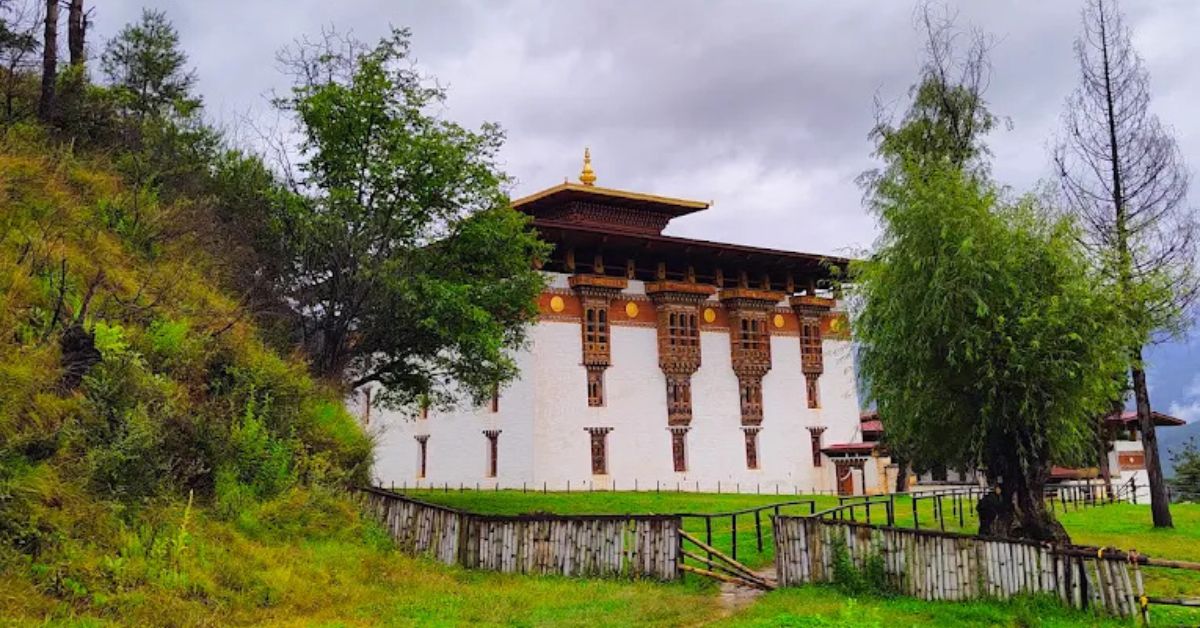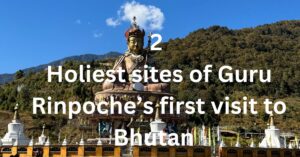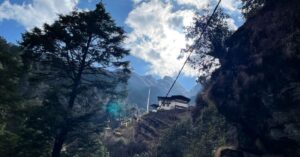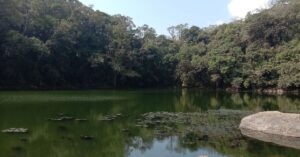Druk Wangditse Lhakhang, the “Temple of the Peak of Conquest”, also known as Zabden Lhundrubtse Dzong, is a 3-story fortress-temple founded by Druk Rabgye in 1715 CE as his residence.
It is situated on a ridge of triumph, located in the same range as Dechen Phodrang Monastery, overlooking Thimphu City with a majestic view of Tashichho Dzong, the National Memorial Chorten, and the great Buddha Dordenma Statue.
Wangditse Dzong was restored in 2020 after being damaged by an earthquake in 2011. Today, Wangditse has become a popular destination for both pilgrims and hikers in the capital city.
How To Reach Druk Wangditse Lhakhang
Wangditse Lhakhang is located 2.5 kilometers from Sangaygang and takes 45 minutes of an easy hike. You must hike to reach the temple, as there’s no road connectivity. There are several routes to reach the Lhakhang. The hiking trails are well-built. From Dechen Phodrang, the hike just takes about half an hour. You can also reach Wangditse from Zilukha.
Wangditse Hike

The Wangditse hike is one of the easiest and best day hikes in Thimphu. You can start hiking from Sangaygang BBS Tower, Dechen Phodrang, or Zilukha Thangthong Dewachen Nunnery. The Phajoding Monastery hike also starts from the BBS Tower at Sangaygang.
Sangaygang Viewpoint is the most popular hiking trail due to its easy hike with minimal ascent. It just takes 45 minutes. From Wangditse, you can also continue hiking further to Choekhortse Lhakhang.
Sacred Relics to See at Druk Wangditse Lhakhang
- Shakyamuni Buddha statue;
- Manjushri and Avalokitesvara;
- Choeten Deshey-Gyed (eight kinds of stupas);
- Goenkhang with protective deities of all 20 districts;
- Dorji Neljorma (Vajra Yogini);
- Jampal Shinje (Manju Yaksha);
- Tandin (Hyagriva);
- Zhabdrung Ngagchang (Zhabdrung in Tantric robe);
- Chana Dorji (Vajrapani);
- Sengdongma (Singha Mukha);
- Dorji Namjom.
History of Druk Wangditse Lhakhang
According to the history of Wangditse temple, the present site of Wangditse was blessed by Zhabdrung Ngawang Namgyal when he traveled from Pangri Zampa Monastery to Paro through Chokhortse Lhakhang and Jela Dzong.
A few generations later, the dzong-cum-Lhakhang was built by Deb Jawo, Khedrup Tenzin Dondrub, or Druk Rabgye, the 8th Desi, in 1715 CE.
Initially, the fortress-temple was named Zhabden Lhendrubtse, Natural Peak of Profound Meaning. However, during the consecration ceremony, Zhabdrung Chogley Namgyal found that the dignitaries from across the country had gathered to attend the ceremony. So, considering the central government’s authority in bringing far-flung areas together to be auspicious, he renamed the temple Druk Wangditse Lhakhang, which means the Temple of Peak of Conquest.
Given its fortress-like appearance, the temple was also called Wangditse Dzong. However, there is no record of how many levels the Wangditse Dzong had. The earliest known sketch of Wangditse temple in 1783 by Samuel Davis shows four levels. While the archaeological survey has found it to be a 3-storied structure. So, it is not known if Davis embellished his drawing or if the floor was later removed, as there is no record of the uppermost floor being removed in subsequent years.
Before the severe damage to Wangditse Lhakhang in 2011, the temple was just 2-storied without a foundation and a surrounding structure. Yet again, there is no record of when and why the Lhakhang was downgraded to a two-story structure.
Importance of Druk Wangditse Lhakhang
Druk Wangditse Lhakhang is one of the oldest temples built in the 18th century in Thimphu. The temple served as a seat of both religious and secular authority, symbolizing the unification of regions under central power. It is also a center where the study of Rigzhung originated.
Damage and Renovations
Over time, the Druk Wangditse Dzong was damaged by frequent earthquakes. The fortress was restored in the 1960s with very minimal alterations to its original structure. In 1995, a renovation was carried out when a windstorm blew away part of the roof, leading to damage to thangkas, wall paintings, and inner relics.
In 2008 and 2009, major renovations were carried out by adding extra support on the ground floor and replacing tilted Kachens in the Goenkhang on the first floor. Unfortunately, Wangditse Dzong was severely damaged by the 2011 earthquake, just like the historic Lingzhi Yugyal Dzong.
Wangditse Dzong Restoration Project
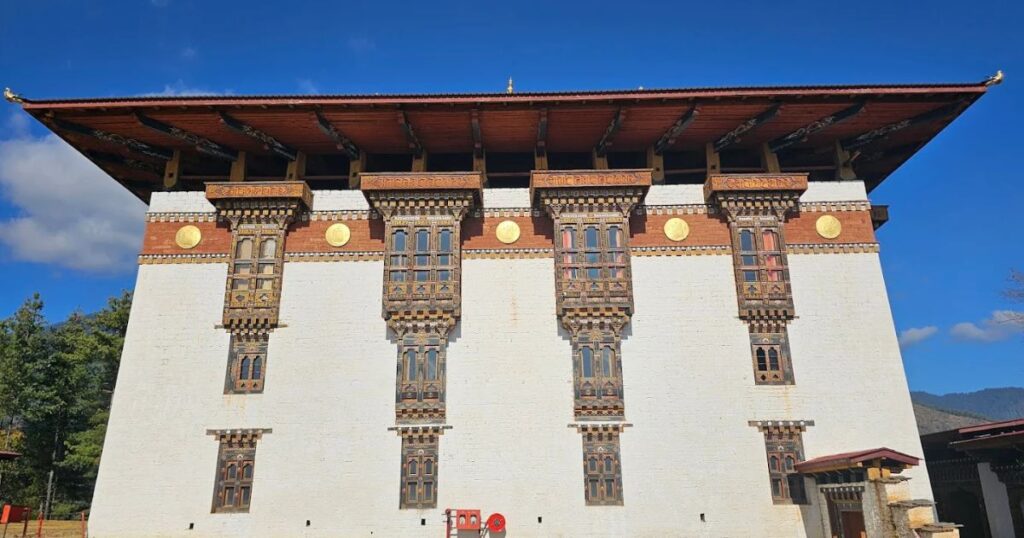
With Royal support under the guidance of Her Majesty Tshering Yangdon Wangchuck, the Wangditse Dzong Restoration Project started in 2013 and was completed in 2020, at a cost of Nu. 154.4 million.
The restoration project was implemented by the Division for Conservation of Heritage Sites based on the temple sketch by Samuel Davis and archaeological findings as a guide to determine the size and style of the original structure.
Wangditse Dzong was reconstructed as a 3-story traditional structure using mud and stones brought from Paro Dawakha and wooden columns from Punakha. The fortress was rebuilt by skilled workers and volunteers from 20 districts, including the graduates of the Institute of Zorig Chusum. They added a Shakhor (surrounding structure), cleaned and restored the main Shakyamuni Buddha statue, Choeten Deshey-Gyed (eight types of stupas), and wall paintings. The inner shrine, Goenkhang, was also enlarged to accommodate Choesungs, the protecting deities of all 20 districts.
Consecration Ceremony of Druk Wangditse Lhakhang
The restored Druk Wangditse Dzong was consecrated, coinciding with the 4th Birth Anniversary of Gyalsey Jigme Namgyel Wangchuck on February 5, 2020. Dorji Lopon of Zhung Dratshang presided over the Tashi Rabney. The consecration ceremony was graced by His Majesty the King, His Majesty the Great Fourth, Their Majesties the Gyalyums, and the members of the Royal Family.
Description of Druk Wangditse Dzong
Druk Wangditse Lhakhang is a 3-story traditional temple with the architecture of a dzong, including the surrounding structure, a Shakhor.
The main inner relic of Wangditse Lhakhang is the 2-story copper-gilded Lord Buddha statue. It is flanked by Jampelyang on the right and Chenrezig on the left. The ground floor also has Desheg Chorten Gye, the 8 great stupas, four on each of the two side walls.
The second floor of Wangditse houses statues of important masters of the Drukpa Kagyu in Bhutan and significant Mahasiddhas. It also has exquisite mandala murals depicting the deities Hayagriva and Vajrakilaya.
The Goenkhang on the third floor houses Choesungs, the protective deities of all 20 Dzongkhags. His Majesty the King also installed life-size images of Dorji Neljorma, Jampal Shinje, Tandin, Zhabdrung Ngagchang, Chana Dorji, and Sengdongma, all in standing wrathful form.
If you walk about eight minutes from the temple, you can see Drupchhu, a holy water source.
Also Read: Drupchhu or Holy Spring Waters in Bhutan: Beliefs and Benefits
Festivals of Wangditse Lhakhang
There is no specific annual festival. However, Druk Wangditse Lhakhang hosts important religious festivals, especially its consecration anniversary, reinforcing its role in unifying Bhutan under central authority.
Best Time to Visit Wangditse Lhakhang
The best seasons to visit Druk Wangditse Lhakhang are in spring, from March to May, and the autumn, from September to November. These months are considered best for the popular Wangditse hike in Thimphu. You can visit the major pilgrimage sites of Bumthang with the Bhutan Pilgrimage Package.
Conclusion
Druk Wangditse Dzong is a historic Goenpa with a panoramic view of Thimphu Valley, popular for pilgrims and hikers. Originally built in 1715 by Druk Rabgye, the 8th Druk Desi, Wangditse Gompa served as a residence for Desis and Thimphu Dzongpons. The temple was severely damaged by an earthquake in 2011 but has since been restored, preserving its original architecture and sacred relics.
Other Sacred Sites to Explore in Thimphu
Buddha Dordenma: It is a massive golden statue of Buddha Shakyamuni overlooking the Thimphu valley. The site also houses thousands of smaller Buddha statues and a meditation hall.
Tashichho Dzong: It is a fortress that houses the king’s throne room, government offices, and the central monastic body. Known as the “Fortress of the Glorious Religion,” it blends religious and administrative functions with stunning Bhutanese architecture.
Pangri Zampa Monastery: It is one of Bhutan’s oldest monasteries, founded in the 16th century by Ngawang Chogyal. The monastery now functions as Bhutan’s Royal College of Astrology, responsible for determining dates for important national events.
Dechenphu Lhakhang: It is a monastery dedicated to Geynyen Jagpa Melen, a powerful protective deity, located at the northern end of the Thimphu Valley in Bhutan. The Temple was constructed in the 12th century by Dampa, the son of Phajo Drugom Zhigpo.
Cheri Monastery: It is the first monastery established in Bhutan by Zhabdrung Ngawang Namgyel in 1620.
Tango Monastery: The Tango Choying Dzong was founded in the 13th century by Phajo Drugom Zhigpo. The monastery is perched on a forested hillside near Cheri Mountain.
Thuji Dra Monastery: It is one of the four cliffs prophesied by Guru Rinpoche to Phajo Drugom Zhigpo. The Thujidra Temple is located at an altitude of nearly 4,000 meters, where Phajo saw in a vision Phagpa Thujechenpo while meditating here.
Enjoyed reading this blog?

